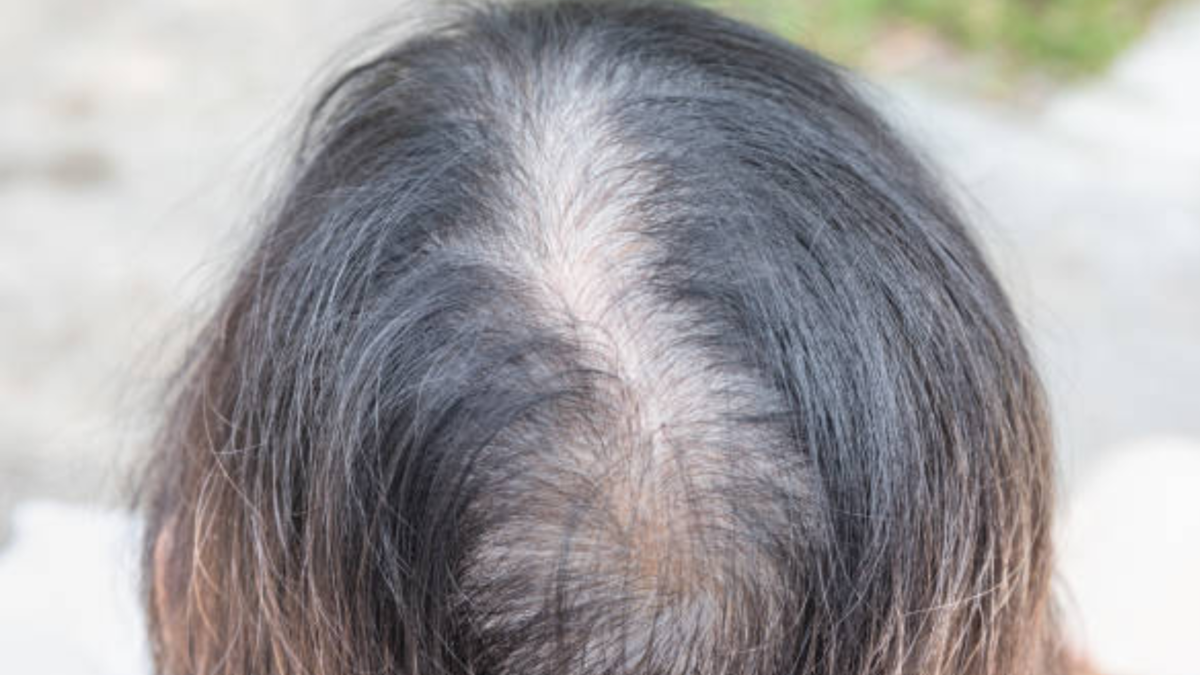


Medically Reviewed By Margaret Etudo. Written By The Vitamins For Woman Team.
Hair thinning after menopause isn’t just a cosmetic issue—it’s a symptom of deeper hormonal changes inside your body.

You wake up one morning, run your fingers through your hair, and more strands than usual are resting on your pillow. The hairbrush begins to fill faster, and your once-thick ponytail feels slimmer with every passing month.
This is menopause hair loss—and it’s more common, more emotional, and more complex than most people realize.
This is why we’re looking at the real causes of menopause-related hair loss, and the four most effective ways to restore your hair’s strength.
Hair loss in menopause isn’t random—it’s a hormonal chain reaction. Once estrogen starts to decline, your hair begins to respond in ways you might not expect.
Hormones are the architects of your hair’s health, and estrogen is one of the keys for women. Throughout your reproductive years, estrogen helps to keep hair in its growth phase longer.
But during menopause, your ovaries gradually produce less estrogen. As this hormone declines, it destabilizes the rhythm of your hair’s natural growth cycle.
Hair that once remained in the anagen (growth) phase for years now shifts more rapidly into the telogen (resting) phase, where it eventually sheds.
Alongside falling estrogen, another player starts to take the lead: testosterone. While women produce far less testosterone than men, it becomes more influential when estrogen dips.
The imbalance between declining estrogen and relatively steady or elevated levels of androgens creates the perfect storm for hair loss.
While hormonal changes are the spark, several other factors can pour fuel on the fire of menopausal hair loss. Stress is one of the biggest.
The transition through menopause often comes with life upheavals. These stressors can spike cortisol levels in the body, which in turn disrupt the hair cycle.
Nutrition also plays a more crucial role than most women realize. Essential nutrients like iron, zinc, vitamin D, and biotin all directly support healthy hair growth. When these nutrients are deficient, hair becomes brittle, growth slows, and breakage increases.
Another overlooked factor is thyroid dysfunction. The thyroid gland, responsible for regulating metabolism, also controls how quickly your hair grows and sheds.
When your hair starts falling out, it can feel impossible to pin down the exact cause. Is it your shampoo? Stress? Diet? Recognizing these signs early on can help you choose more effective treatment paths.
One of the most recognizable signs of hormonal hair loss during menopause is thinning at the crown of the head or around the temples. You might notice that your part looks wider, or that more of your scalp is visible in the mirror than it used to be.
Unlike hair loss from breakage or scalp irritation, which tends to be patchy, hormonal thinning follows a predictable pattern. The front hairline is usually preserved, but the hair behind it becomes sparse and wispy.
This pattern mirrors a type of androgenetic alopecia, which is influenced by the rise in DHT (dihydrotestosterone) that can happen as estrogen declines.
You’re brushing your hair as usual, but the brush is fuller lately. Or perhaps you’re washing your hair and more strands than normal gather near the drain. This isn’t an illusion.
Hormonal hair loss tends to cause more hair to shed during grooming activities. That’s because hormonal imbalance accelerates the shift from the growing phase of the hair cycle to the shedding phase.
While each hair loss might seem minor, the cumulative effect over weeks and months leads to visible thinning, especially around the top of the head.
You may also notice that your hair isn’t growing as fast as it used to. Maybe you cut your hair expecting it to bounce back in a few months—but it stays stuck at the same length for ages.
Sluggish hair growth is another silent symptom of hormonal hair loss.
This happens because estrogen plays a critical role in keeping your hair in the anagen (growth) phase. As estrogen levels fall, the hair cycle shortens, meaning your hair grows for a shorter period before entering rest and shedding phases.
The result is less hair growing in and a frustrating slowdown in regrowth after hair is lost.
Even if you’re not losing a ton of hair, your texture has changed. Your once-glossy strands may start to feel rougher, frizzier, and more prone to snapping.
Estrogen helps retain moisture in both the scalp and the hair shaft. The skin and scalp dry out when it drops, and hair strands become more porous.
If your hair breaks off more than falling out from the root, it could still be part of the hormonal hair loss spectrum.
Sometimes, menopause hair loss shows up as sudden, massive shedding—a condition known as telogen effluvium.
This type of hair loss isn’t gradual. It can feel like a switch was flipped. You might suddenly lose handfuls of hair over a short span of weeks.
Telogen effluvium occurs when many hair follicles prematurely enter the resting phase of the hair cycle. While this condition can be triggered by stress, illness, or nutritional deficiencies, menopause frequently triggers it because of abrupt hormonal shifts.
The good news? Hair loss due to menopause isn’t always permanent. With the right interventions, many women stop the shedding and restore the strength, shine, and fullness they thought was lost forever
Topical treatments work directly on the scalp and hair follicles. Minoxidil. It increases blood flow to the scalp, prolongs the growth phase of the hair cycle, and revives dormant follicles.
For women experiencing thinning at the crown or diffuse hair loss, minoxidil can stimulate regrowth and visibly thicken hair with consistent use over several months.
But not every woman wants a pharmaceutical solution. Natural alternatives like peppermint oil offer a gentler, though still effective, route.
Peppermint oil increases circulation to the scalp and has shown promising results in stimulating follicular activity. It’s also less likely to cause the itching or flaking that sometimes accompanies minoxidil.
When hair follicles don’t get the nutrients they need, they stop functioning at full capacity. This is where targeted supplementation becomes essential.
Biotin, also known as vitamin B7, is critical for keratin infrastructure. When taken consistently, it can help improve hair strength and growth speed.
Collagen supplements, mainly hydrolyzed marine collagen, provide amino acids that form the structure of hair, skin, and nails.
Iron is another cornerstone nutrient, especially for women who are still perimenopausal and may have heavy periods before entering full menopause.
Hormone Replacement Therapy, or HRT, is one of the most direct ways to address menopause hair loss—because it targets the root hormonal imbalances.
By reintroducing estrogen and, in some cases, progesterone into the body, HRT can help restore the hair cycle’s natural rhythm and reduce androgenic effects like follicle miniaturization.
For women whose hair loss is linked to a sharp drop in estrogen, HRT can be transformative. However, it is not a one-size-fits-all solution.
Some women experience side effects, and HRT isn’t suitable for everyone, especially those with a history of certain cancers, blood clots, or liver issues.
What you eat—and how you live—has an enormous impact on how your body handles the hormonal transition.
Diets high in refined sugars and processed carbohydrates can wreak havoc on your insulin response, which in turn destabilizes hormones like testosterone and DHT.
By balancing your blood sugar with a diet rich in whole grains, healthy fats, lean protein, and lots of leafy greens, you create a more stable hormonal environment for your hair follicles to thrive.
Stress reduction is just as critical. Chronic stress raises cortisol, suppresses thyroid function, decreases collagen production, and encourages scalp inflammation, all of which accelerate hair loss.
Regular movement, deep breathing exercises, journaling, and even adaptogenic herbs like sage can make a measurable difference.
Hair loss during menopause is common—but not all hair loss is ” normal.” Knowing when to involve a healthcare professional to rule out underlying conditions or receive specialized treatments. You should consider seeing a doctor if:
A doctor may recommend hormone level testing, thyroid function tests, or a scalp biopsy to get to the root of the issue.
Yes, it can—but it depends on the underlying cause and how early you begin treatment. If the hair loss is due to hormonal shifts, stress, or nutritional deficiencies, there is a strong chance of regrowth once those issues are addressed. However, regrowth may be partial or slower if the follicles have miniaturized over many years (as seen in androgenic alopecia).
Iron, vitamin D, and B vitamins (especially biotin) are the most commonly implicated deficiencies in menopausal hair loss. Iron is essential for carrying oxygen to your hair follicles; without it, follicles shrink and shed prematurely. Vitamin D, meanwhile, plays a role in the hair cycle and immune function; deficiency has been linked to autoimmune hair loss conditions like alopecia areata.
Hormone Replacement Therapy (HRT) can help—particularly in cases where hair loss is linked to low estrogen levels. Estrogen helps extend the hair cycle’s anagen (growth) phase, so replacing it can prevent or reduce thinning.
Hair loss during menopause can shake your confidence in ways that go beyond appearance. It’s not just about thinning strands—it’s about feeling like you’re losing a part of yourself in a phase of life that’s already full of change.
But this doesn’t have to be your new normal. From balancing hormones to nourishing your scalp from the inside out, some solutions work. The journey takes patience, but with the right tools, support, and mindset, you can restore your hair and your sense of self.

medically reviewed by margaret etudo, BPharm. written by the vitamins for woman team.